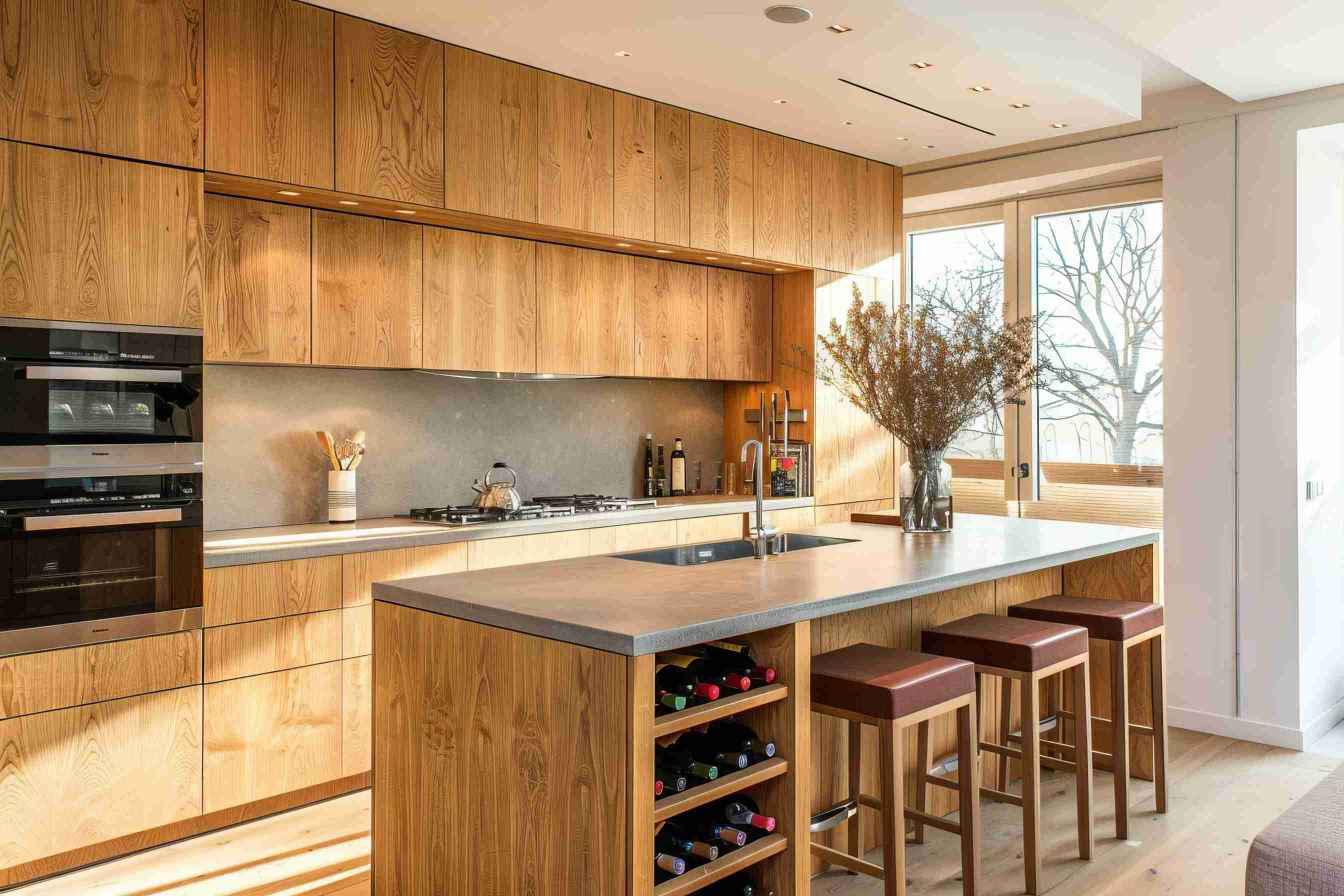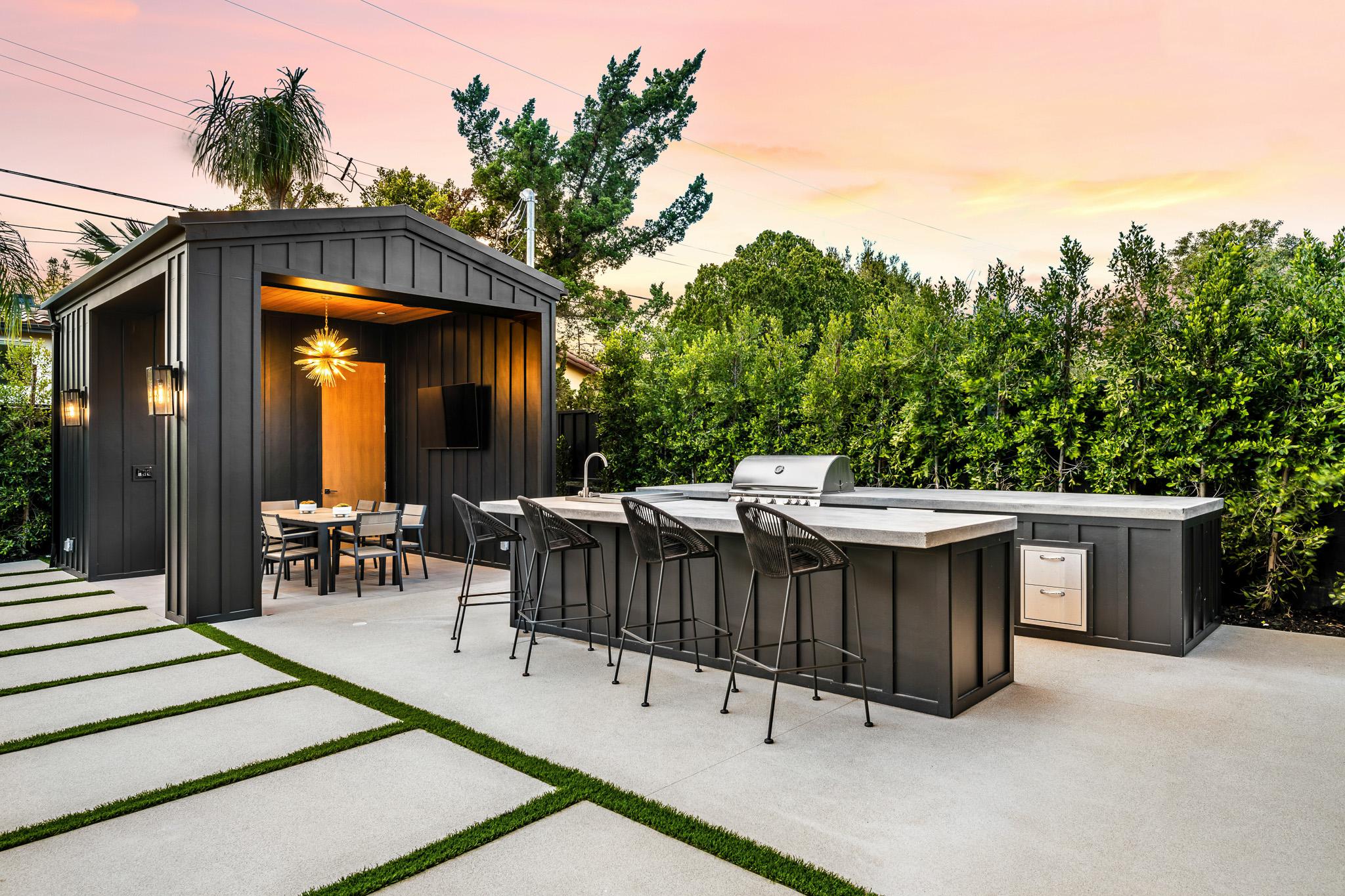If you want to give your kitchen a fresh update, staining oak cabinets can provide a transformative touch without needing a full paint job. Whether you’re aiming for a classic or contemporary look, follow our guide on how to stain your oak cabinets.
How to Restain Oak Cabinets
There are different methods for restaining oak cabinets, which can give your kitchen a fresh update without the cost of entirely new cabinets. The three most common ways to start this process are by sanding, chemical stripping, or dulling the cabinets.
Traditional sanding and restaining
This method is effective for completely changing the color of the cabinets or refreshing their appearance. It involves removing the existing finish from the oak cabinets by sanding them down. After cleaning off dust or debris, a new stain is applied to achieve the desired color. Finally, a clear sealant is applied to protect the finish and enhance durability.
Chemical stripping and restaining
This method is helpful for cabinets with multiple layers of old finish or stubborn stains. A chemical stripping agent is applied to the cabinets to remove the existing finish. Once the old finish is stripped away, the cabinets are cleaned and prepared for restaining. A new stain is applied to achieve the desired color, followed by a clear sealant to protect the finish.
Deglossing and restaining
This method is ideal for cabinets with a relatively good condition finish that only requires a color change or refresh. It involves using a liquid deglazer to remove the gloss from the existing finish on the cabinets. After cleaning off any residue from the deglosser, a new stain is applied directly over the existing finish. Once the stain has dried, a clear sealant is applied to protect the finish and enhance durability.
How to Stain Unfinished Oak Cabinets
Before diving into the step-by-step process of staining your oak cabinets, gathering all the necessary materials and tools is important.
Tools and materials
- Stain
- Clear polyurethane sealant
- Cleaning supplies
- Fine-grit sandpaper
- Screwdriver
- Sheet sander
- Brushes or cloths
- Paintbrush or roller
- Work gloves and safety goggles
- Drop cloths or tarps
- Ladder or step stool
- Painter’s tape
Step-by-Step
- Removing cabinets: Start taking down all the cabinet doors and drawers. Labeling them with numbers can simplify the reinstallation process later on if you have a sizable number of cabinets. Place all the corresponding hardware, like hinges and screws, in labeled baggies to keep everything organized.
- Sanding: Smooth surfaces are crucial to achieving a flawless stain application. Utilize a sheet sander for larger, flat areas of the cabinets to ensure even sanding. Manual sanding with fine-grit sandpaper is necessary for intricate or curved sections to reach every nook and cranny. Once the sanding is complete, thoroughly clean the cabinets to remove any lingering sawdust.
- Applying stain and sealing: Apply at least two thin coats of stain using a brush or cloth. Following the grain of the wood will help you achieve a uniform finish. Avoid applying too much stain at once, as it can lead to uneven coloration or blotching. Once the doors are stained to your satisfaction, move on to the cabinet boxes, repeating the staining process.
- Sealing: After the stain has fully dried, seal the cabinets with a clear polyurethane sealant to protect the finish and enhance durability.
- Putting it back together: With the staining and sealing complete, it’s time to reassemble your cabinets. Align each door and drawer carefully, ensuring hinges and hardware are securely attached. Take your time during this step to ensure everything lines up perfectly, giving your kitchen that polished, professional look.
Can You Stain Oak Cabinets Without Sanding?
Yes, you can stain oak cabinets without sanding, but it’s generally not recommended for achieving the best results. Sanding helps to smooth the surface, remove any existing finish or imperfections, and allow the new stain to penetrate the wood evenly. As mentioned earlier in this post, you can also use chemical stripping or dulling agents depending on your oak cabinets’ current paint/finish.
Keep in mind that the new stain may not adhere well or provide a uniform finish without sanding. Additionally, the final result may be affected by the condition of the existing finish and the type of stain you choose. Always test a small area first to ensure compatibility and desired results before applying the stain to the entire surface.
If you’re staining oak cabinets without sanding, thoroughly clean the cabinets with a degreasing cleaner to remove any dirt, grease, or grime before applying the stain. This will help ensure better adhesion and a more uniform finish. Additionally, consider using a liquid sanding product, which can help degloss the existing finish and improve stain adhesion without traditional sanding.
What is The Best Stain for Oak Cabinets?

Golden Pecan is a popular choice for staining oak cabinets. Its warm, golden color adds richness without covering up the wood’s natural grain. This stain gives cabinets a mature and stylish look that works well in any kitchen.
When picking the best stain for oak cabinets, consider factors like transparency, whether it works well with oak wood and its durability.
Can Oak Cabinets be Stained a Different Color?
Yes, oak cabinets can be stained a different color. Staining oak cabinets allows you to change or enhance their appearance to better suit your desired aesthetic or decor style. Staining offers flexibility and versatility whether you want to darken, lighten, or completely change the color of your oak cabinets. Staining oak cabinets a different color can be a cost-effective way to refresh and update your kitchen’s look.
Are Stained Oak Cabinets Out of Style?
Stained oak cabinets are not out of style. They are still very much in fashion. According to the latest report from the National Kitchen & Bath Association, homeowners are moving away from plain white cabinets and opting for warmer wood finishes like walnut and white oak. They offer a classic and cozy look that fits the trend of bringing natural elements into kitchen designs.
Kitchen Renovation: Beyond Cabinet Staining
If you’re planning a more extensive kitchen transformation beyond cabinet staining, you might find it helpful to explore additional insights on planning for a kitchen remodel. Check out our comprehensive guide for pro tips on layout, budgeting, and design considerations to guide you through renovation.
Conclusion
Staining oak cabinets is a great way to breathe new life into your kitchen. With the flexibility to choose from warm wood finishes like walnut and white oak, you can stay on-trend while embracing the timeless aesthetic of stained oak cabinets. If you’re unsure about tackling the staining process, remember to call a professional team for customized design and installation, ensuring your cabinets are perfectly finished.




